Chinese Nuclear Arsenal Increased by 25 Percent Since 2006, Pentagon Report Indicates
 |
| China’s nuclear weapons arsenal has increased by 25 percent since 2006, Pentagon reports indicate, due to deployment of new ballistic and cruise missiles. |
By Hans M. Kristensen
| Updated April 8, 2008 |
The Pentagon’s 2008 annual report to Congress on China’s military power indicates, when compared with previous versions, that China has increased its nuclear arsenal by 25 percent since 2006. The increase has happened due to deployment of new long-range solid fueled ballistic missiles and cruise missiles.
Part of the increase can be expected to be offset by retirement of older liquid fueled missiles over the next several years, but the trend is toward a slightly larger arsenal in the future.
As a reminder of the tendency to estimate too much too soon, however, the 2008 report lowers the range estimates for all three types of China’s new long-range ballistic missiles, one of them by as much as 10 percent.
DF-31 and DF-31A Being Deployed
A decade after the Department of Defense (DOD) first projected the DF-31 would be deployed, the 2008 report finally concludes that the missile is “now being deployed to units within the Second Artillery Corps.” The report lists less than 10 (“<10”) DF-31 missiles deployed on as many launchers. Last year’s report listed the DF-31 as having achieved “initial threat availability in 2006” and possible “operational status” by May 2007.
| Figure 1: DF-31 Deployment Said to be Underway |
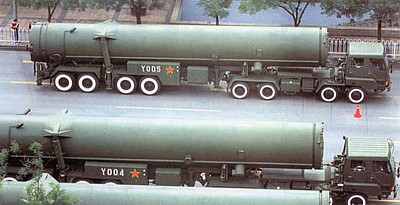 |
| The DOD reports says the DF-31 (shown here) and its longer-range DF-31A version are now being deployed to Second Artillery Corps units. |
–
More surprising is that the DF-31A is now said to be deploying. The missile, which is a longer-range version of the DF-31, has not previously been reported flight tested or with “initial threat availability,” but less than 10 missiles are now said to be deploying to Second Artillery Corps units. Like the DF-5, which has been operational since 1981, the DF-31A can target the Continental United States, and much of the intelligence community’s 2001 prediction of “about 75 to 100 warheads deployed primarily against the United States” by 2015 hinges upon whether China deploys 40-55 DF-31As over the next eight years (see pp. 39-41 in Chinese Nuclear Forces and U.S. Nuclear War Planning, FAS/NRDC, November 2006).
The range estimates for both missiles are lowered. The range for the DF-31 is lowered by 50 km from 7,250+ to 7,200 km (4,505+ to 4,474 miles), after it was thought only a few year ago that the range was 8,000+ km (4,971+). The DF-31 cannot be used to target the Continental United States, and will only be able to reach Hawaii from the most North-Eastern districts of China.
The DF-31A range estimate is lowered from 11,270+ to 11,200 (7,003+ to 6,959+ miles), or to a range 14 percent less than that of the DF-5A.
The Mysterious Growth of the DF-21 Force
A significant portion of the arsenal increase comes from additional DF-21 (CSS-5) that the Pentagon says have been deployed since 2006. The 2008 report estimates that 60-80 DF-21s are now deployed with 60 launchers, significantly more than the 40-50 missiles estimated to be deployed with 34-38 launchers in 2007, and the 19-50 missiles stated in the 2006 report.
Previous versions of the DOD report listed two versions of the DF-21 – Mod 1 and Mod 2 – but the 2008 report only lists one nuclear version with no Mod-number.
It is possible, although not clear from the DOD report, that the 60-80 DF-21s include the “conventionally-armed ASBMs [Anti-Ship Ballistic Missiles] based on the SS-5 (DF-21) airframe,” that the report also describe. Since the “Nuclear Force Structure” section of the report only describes “upwards of 50 CSS-5 road mobile, solid fueled SRBMs (for regional deterrence missions),” it is possible that the remaining 20, or so, DF-21s refer to the conventional ASBMs. Consequently, I have only counted 60 nuclear DF-21s in this estimate.
In July 2007, I described changes to the missile launch sites at Delingha, which indicated deployment of DF-21 missiles at the sites (see Figure 2). The DF-21 has been replacing DF-3As since the early 1990s at a slow rate.
| Figure 2: Possible DF-21 Deployment at Delingha |
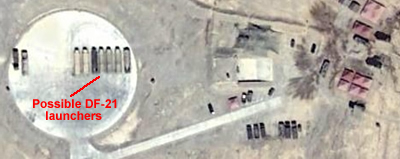 |
| An increase in deployed DF-21 medium-range ballistic missiles is reported by the Pentagon. Commercial satellite images in 2007 indicated possible DF-21 deployment at Delingha in the northern parts of Central China. |
–
DF-25, What DF-25?
The DOD report is quiet on the new missile launcher that appeared on images (see Figure 3) circulating on the Internet in 2007. The images led many to speculate that the earlier DF-25, widely believed to have been canceled, had been revived and deployed with as many as three nuclear warheads.
I doubted that assessment – China is not known to have deployed multiple warheads on any of its ballistic missiles – and asked Air Force Intelligence officials on several occasions last year to comment on the images. They told me that they had seen the photo but were not ready to officially comment yet. Nor is apparently the Office of the Secretary of Defense, and the silence of the 2008 report on this development indicates that the “DF-25” instead may be the “conventionally-armed [Anti-Ship Ballistic Missile] based on the CSS-5 (DF-21) airframe.”
| Figure 3: Possible Modified DF-21 Launcher |
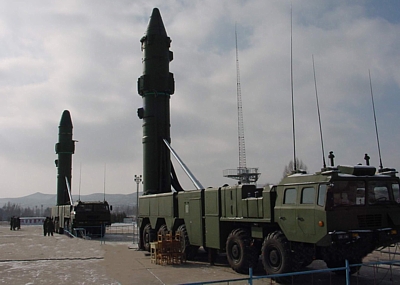 |
| Images circulated on the Internet in 2007 showed what many concluded was a DF-25 launcher. The DOD report does not confirm or comment on the existence of a DF-25, but lists one nuclear and one conventional DF-21. |
–
DH-10 Cruise Missile Deployed
The DOD report also states that China has now deployed the DH-10 cruise missile; an unspecific 50-250 missiles on 20-30 launchers. The DH-10, which appears to be a Chinese version of the U.S. Tomahawk cruise missile, can carry either a conventional or nuclear warhead and has a range or more than 2,000 km (1,243+ miles). Both air- and ground-launched versions are said to exist, and the H-6 bomber appears to be undergoing an upgrade to carry up to six DH-10s (see Figure 4).
| Figure 4: DH-10 Cruise Missile Deployed |
 |
| The DOD report says China has deployed 50-250 DH-10 land-attack cruise missiles. The H-6 bomber is being upgraded to carry perhaps up to six missiles (see above), which can also be fired from ground-based launchers. sinodefenceforum.com |
–
The DOD report does not give an estimate for how many nuclear variants of the DH-10 are deployed with ground forces or H-6 wings, and the vague 50-250 total estimate leaves much uncertainty. A medium range estimate (150) might be a reasonable total estimate, of which perhaps only a dozen or so may be nuclear at this stage.
Submarine Force Modernizing But Stable
Curiously, only one Jin-class SSBN is mentioned, although commercial satellite images clearly show that at least two are under construction. In contrast to the 2007 report, however, the 2008 version gives a somewhat halfhearted endorsement the projection made by the Office of Naval Intelligence in 2007, by saying that China “will likely” build “up to five JIN-class SSBNs.” This is a less certain prediction than the one made by ONI, which said a fleet of “probably five TYPE 094 class SSBNs will be built….” On the other hand, while ONI avoided setting a year, the DOD report predicts that it will likely be 2010. But that seems a highly unrealistic projection, given that none of the Jin-class SSBNs are yet operational and that only two hulls have been launched so far.
As for sea-launched ballistic missiles, the DOD report no longer lists the JL-1, indicating that the weapon system is not considered fully operational. It has probably never been, but this is the first time the missile chart in the DOD report reflects that reality.
The new JL-2 is also not operational, but included in the missile chart. Initial Operational Capability might be achieved in 2009-2010, DOD predicts. The estimate for the JL-2’s range, however, is lowered by 10 percent from 8,000+ to 7,200+ km (4,971+ to 4,474 miles). The 8,000+ km estimate has long been questionable, and the new estimate is the same as for the DF-31 from which the JL-2 is derived. The JL-2 cannot target the Continental United States from Chinese waters, and will have to sail into the Sea of Japan or past the Japan-Okinawa island chain to target Hawaii.
Mysteriously, the DOD report continues the practice from last year of assigning 10-14 missiles to each Chinese SSBNs, a curious estimate given that images of the boats clearly show 12 launch tubes.
As for the SSBN mission, the DOD report echoes my conclusion that despite construction of new SSBNs, the lack of deterrent patrols means that China essentially has no experience in operating a sea-based deterrent in a way that would matter strategically. According to the DOD report, “the PLA has only a limited capacity to communicate with submarines at sea and the PLA Navy has no experience in managing an SSBN fleet that performs strategic patrols.”
Overall, despite recent media reports about “rapid expansion” of the Chinese submarine fleet, the DOD report shows an attack submarine fleet that is relatively stable around 54 diesel submarines and 4-5 nuclear-powered attack submarines. Although new diesel submarines are being commissioned, older types are being retired at the same time. Only 4 of the old Han-class SSNs are left, and the report leaves some confusion about the status of the new Shang-class SSN by including it in the naval forces table but stating elsewhere that it is not expected to be operational until 2010.
Nuclear (Military) Talks Underway
Finally, what the report doesn’t describe, but which the Pentagon announced earlier this week, is that China and the United States have now “agreed to move forward on our dialogue on nuclear strategy and policy.” A process is “in place now,” DOD says, that over the next couple of months will begin with “a discussion between Chinese military officers and Chinese military academics and counterparts here in the U.S.” An invitation was extended in November 2006 to General Jing Zhiyuan, head of Second Artillery Corps, to meet directly with his counterpart at U.S. Strategic Command.
Read more: Chinese Nuclear Forces and U.S. Nuclear War Planning
Chinese Submarine Patrols Rebound in 2007, but Remain Limited

By Hans M. Kristensen
China’s entire fleet of approximately 55 general-purpose submarines conducted a total of six patrols during 2007, slightly better than the two patrols conducted in 2006 and zero in 2005.
The 2007 performance matches China’s all-time high of six patrols conducted in 2000, the only two years since 1981 that Chinese submarines conducted more than five patrols in a single year.
The new information, obtained by Federation of American Scientists from the U.S. Navy under the Freedom of Information Act, also shows that none of China’s ballistic missile submarines have ever conducted a deterrent patrol.
In Perspective
Just what constitutes a Chinese “patrol” is secret, according to the U.S. Navy, but it probably refers to an extended voyage away from the homeport area (see here for further definitions). The seven Chinese patrols conducted in 2007 is but a fraction of the number of patrols conducted by the U.S. submarine force, which musters well over 100 patrols per year. But a comparison of U.S. and Chinese submarine patrol levels is not possible because the two navies have very different missions. China has no overseas military commitments and uses its submarine fleet almost exclusively as a coastal defense force, whereas the U.S. submarine force is constantly engaged in forward operations alone or with allies.
The Chinese patrol rate compares better with that of the Russian Navy, which has largely ceased forward submarine operations compared with those of the Soviet Union during the Cold War. Russian general purpose submarines conducted seven patrols in 2007.
|
Chinese Submarine Patrols 1981-2007 |
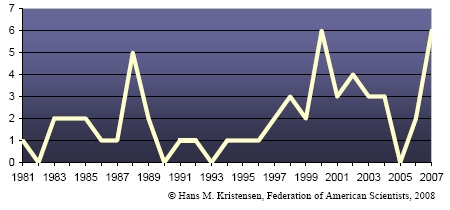 |
|
The entire Chinese submarine fleet conducted six patrols during 2007, matching the previous all-time high from 2000. The performance indicates that China operates its submarine fleet almost entirely as a coastal defense force. |
–
In historic perspective, the six Chinese submarine patrols conducted in 2007 continues a trend that China in this decade has sent slightly more submarines on patrol than during the 1990s. Whereas Chinese submarines in the 1990s conducted an average of 1.2 patrols each year, the average has been 3.4 patrols since 2000.
About Those Boomers
Twenty-five years after it launched its first ballistic missiles submarine, Xia (Type 092), China has yet to conduct its first deterrent patrol. The new information confirms that neither the Xia, nor the two new Jin-class (Type 094) ballistic missile submarines – the first of which was launched in 2004 – have ever conducted a deterrent patrol.
The single-warhead Julang-1 sea-launched ballistic missile developed for the Xia has been test launched twice, but is not thought to be fully operational and has been referred to by the U.S. intelligence community for years as the CSS-NX-3 (X for experimental). Each Jin-class submarine has 12 launch tubes for the new Julang-2 sea-launched ballistic missile, which the U.S. intelligence community estimates will carry a single warhead.
|
China’s New Nuclear Submarines |
 |
|
China’s new Chang-class (Type-093) nuclear-powered attack submarine (top) and Jin-class (Type-094) nuclear-powered sea-launched ballistic missile submarine (bottom) were photographed at the Xiaopingdao submarine base near Dalian by the Quickbird satellite on May 3, 2007, and October 17, 2006, respectively. A comparison of the two images shows the different size of the two submarines: roughly 100 meters versus 135 meters. |
–
The future mission of the missile submarines appears to be regional because the range of the missiles and operational constraints facing the submarines limit the targets that can be held at risk. The range of the Julang-2 is estimated by the US intelligence community at more than 8,000 km (4,970+ miles), which brings Hawaii and Alaska (but not the continental United States) within reach from Chinese territorial waters. Assuming they made it out of port past lurking U.S. attack submarines, the Chinese missile submarines would have to sail through the narrow straight between South Korea and Japan into the Sea of Japan for its Julang-2 missiles to be able to strike the Seattle area.
The Bo Hai Bay has been suggested as a possible deployment area for China’s missile submarines because it would offer more protection against hostile attack submarines. From the shallow bay, the Julang-2 missiles could be used to target Guam and Alaska, India, Russia, and – at the limit of its range – Hawaii.
There are also rumors – one apparently even with a photo – that China may plan to homeport some of its ballistic missile submarines at the new submarine base under construction at Hainan Island in the South China Sea. The infrastructure includes what appears to be a waterway entrance to an underground facility similar to the underground facility at Jianggezhuang submarine base near Qingdao where the Xia is based. Hainan Island has access to deeper waters than Jianggezhuang, but is also less protected. From Hainan Island the Julang-2 would be within range of Guam, India and most of Russia, but not Hawaii.
The U.S. Navy has assessed that China might build as many as five Jin-class submarines “in order to provide more redundancy and capacity for a near-continuous at-sea SSBN presence,” but is yet unclear whether China plans to develop a near-continuous sea-based deterrent or just a surge capability for deployment in a crisis. If all current ballistic missile boats became fully operational, China could deploy a maximum of 36 warheads at sea, although at least one of the boats would probably be in overhaul at any given time. Whatever the future mission, absent any deterrent patrols so far, the Chinese military will first have to learn how to operate the missile submarines in a way that would matter.
Implications
Despite the rebound in general purpose submarine patrols, dramatic reports from recent years about Chinese submarines operating inside Japanese territorial waters or surfacing close to U.S. aircraft carriers have been largely absent in 2007. The meaning of the patrol rebound is yet unclear. After all, it follows a complete absence of submarine patrols in 2005, the fourth year since 1981 that China’s submarine fleet did not conduct any patrols despite introduction of several new classes of more advanced submarines for greater reach. That modernization has (not yet) manifested itself in the form of a clear increase in submarine patrols.
The patrol number does not say anything about what the submarines did during the six patrols. They might have been basic attempts to sail far from shore to test navigational equipment or communication with the homebase, or they might have included more advanced tactical operations. They might have been conducted by six different submarines, or only a couple.
Yet for the Chinese submarine force overall, six patrols do not provide very much operational experience for more than 50 submarines and their crews. If China did plan a more extended reach for its submarine force, one might expect the patrol rate to continue to increase in the next couple of years. Only the future will tell. But the operational experience from the 55 patrols conducted by the entire submarine force between 1981 and the end of 2007 suggests that China’s submarine force – at least for now – remains a coastal defense force.
More information: browse previous blogs about China | Chinese Nuclear Forces and U.S. Nuclear War Planning
A Closer Look at China’s New SSBNs
By Hans M. Kristensen
The two new Jin-class SSBNs I discovered on Google Earth earlier this month have now been photographed in port by an anonymous photographer. The photograph, which has appeared on several Chinese web sites (here and here) and sent to me by David, clearly shows the features of what I estimated to be the Jin-class submarine.
Nothing is known about who took this photograph or whether or not it has been digitally manipulated. But if it is authentic, it appears to lay to rest speculations that the Jin-class would carry 16 missiles. Instead the photograph confirms the assessment made by the U.S. intelligence community by clearly showing the wide-open hatches of 12 launch tubes.
The photograph shows the submarines at an angle, which makes it difficult to precisely measure the length of the various sections. Furthermore, he second submarine on the other side of the pier is obscured by the submarine closest to the camera, making comparison of the two impossible. Yet, a comparison made from the satellite images on my previous blog show that the two submarines have the same overall dimensions.
The new photograph shows the sail of both submarines, which appear to be very similar. Moreover, the front submarine shows a unique feature on the top of the rudder section, which may be a sensor of some kind.
Overall, it is not as if the Chinese are trying to hide anything. Indeed, it is almost as if they want to show what they’ve got.
Background: Chinese Nuclear Forces and U.S. Nuclear War Planning
Two More Chinese SSBNs Spotted
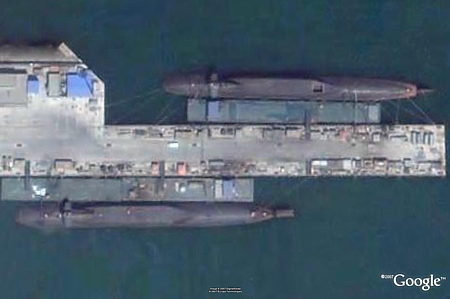 |
|
China appears to have launched two more SSBNs. |
By Hans M. Kristensen (BLOG UPDATED OCTOBER 10, 2007)
China appears to have launched two more ballistic missiles submarines from the Bohai shipyard at Huludao approximately 400 km east of Beijing. This could bring to three the number of Jin-class (Type 094) nuclear-powered ballistic missile submarines (SSBNs) launched by China in the past three to four years.
The two submarines were discovered during analysis of newly published commercial satellite images on Google Earth. This is the second time in three months that FAS has discovered new Chinese ballistic missile submarines on commercial satellite images. The first time was in July 2007, when the first Jin-class was disclosed on the FAS Strategic Security Blog.
The submarines on the new image have the same dimensions as the previous submarine.
So How Many Do They Have?
Whether China has now launched two or three Jin-class SSBNs is still unclear. The image of the first SSBN discovered at Xiaopingdao in July 2007 was taken on October 17, 2006. The new image of the two SSBNs at Huludao was taken six and a half months later on May 3, 2007. One possibility is that the Xiaopingdao SSBN returned to Huludao for repair or further adjustment and was captured on the 2007 photo together with the second SSBN. Another possibility is that the two Huludao SSBNs are indeed the second and third boats of the new Jin-class SSBN.
The U.S. Office of Naval Intelligence estimated in December 2006 that “a fleet of probably five TYPE 094 SSBNs will be built in order to provide more redundancy and capacity for a near-continuous at-sea SSBN presence.” China has not stated how many SSBNs it plans to build and there is no authoritative information available in the public that confirms that China plans to build five SSBNs. It might, but it might also build less if it decides that three or four are sufficient.
Some Implications
The new Jin-class SSBNs add to the single and unsuccessful Xia-class (Type 092) that China launched in 1982. The Xia has never conducted a deterrent patrol and its operational status is in doubt. The rapid launch of two or three Jin-class SSBNs indicate that the Chinese navy feels confident it has overcome at least some of the technical problems that curtailed the Xia.
|
|
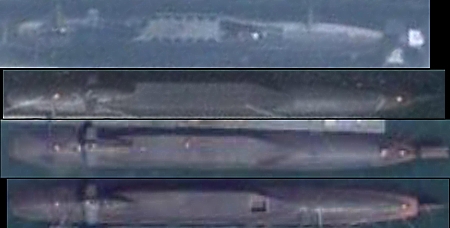 |
|
Comparison of Chinese SSBNs discovered on commercial satellite images made available on Google Earth since 2005 show clear differences between the Xia-class (Type-092) and the new Jin-class (Type 094). The roughly 23-meter missile compartment on the Xia (top) has been extended to about 34 meters on the Jin-class. The Jin-class photographed at Xiaopingdao (second from top) and the two at Huludao have the same dimensions, indicating that China has launched at least two boats. To download larger image, click on the image above or here. |
Each Jin-class appears to have 12 launch tubes for the new Julang-2 sea-launched ballistic missiles that are currently under development. If Julang-2 and three Jin-class SSBNs become fully operational, it would enable China to deploy up to 24 ballistic missiles at sea, assuming one boat would be in overhaul at any given time (and the Xia is still not operational). The range of the Julang-2 is estimated by the US intelligence community at more than 8,000 km (4,970+ miles), which brings Hawaii and Alaska (but not the continental United States) within reach from Chinese territorial waters.
Despite many rumors on the Internet about multiple warheads on Julang-2, the long-held assessment by the US intelligence community is that the Julang-2 will be a single-warhead missile.
Whether China plans to deploy a continuous sea-based deterrent is unknown. It appears doubtful because it would break with the Chinese practice of not deploying fully operational nuclear missiles. Nuclear warheads for China’s land-based missiles are believed to be stored separate from the missiles, although this has never actually been verified for the entire force. If the submarines deployed into the Pacific (like U.S. and to a smaller extent Russian SSBNs) it would also break with Chinese policy of not deploying nuclear weapons outside Chinese territory. An alternative would be to operate the SSBNs as a surge capability, intended to deploy in a crisis.
Background: Other Blogs About China
Nuclear Arms Racing in the Post-Cold War Era: Who is the Smallest?
 |
|
China and the Uniked Kingdom have started a new arms race over who has the smallest nuclear weapons arsenal. |
By Hans M. Kristensen
Mine is smaller! No, mine is smaller!!
China and the United Kingdom have started a new type of nuclear arms race for the honor to have the smallest number of nuclear weapons.
In April 2004, the Chinese Foreign Ministry declared in the fact sheet China: Nuclear Disarmament and Reduction of: “Among the nuclear-weapon states, China…possesses the smallest nuclear arsenal.”
In May 2007, British Defense Minister Des Browne stated in a written response to a parliamentary question that the United Kingdom has “the smallest stockpile of any of the nuclear weapon states recognised under the NPT.”
Apparently, the race is on for who is the smallest.
So Who Is The Smallest Nuclear Power?
The size of the nuclear weapons inventory of both countries is secret, but it is possible to make best estimates.
Britain announced in December 2006 that it had reduced the number of “operationally available warheads” from fewer than 200 to “less than 160.” The gesture was somewhat hollow, however, because Britain hasn’t had room for more than 144 warheads on its Trident D5 missiles for years. Moreover, the language hints that Britain has more nuclear warheads in storage. Assuming it retains a small reserve, the total British stockpile is probably around 200 warheads.
The British government has stated that the single SSBN on patrol at any given time carries “up to 48” warheads, a statement that partly reflects that some of the missiles have been given a “substrategic” mission, probably with only one warhead each. Depending on the number of substrategic mission missiles carried, the actual loading of the patrolling submarine probably is 36-44 warheads. Assuming a similar loading for the other two SSBNs for which there are missiles available, the estimated number of warheads needed for the British SSBN fleet since the substrategic mission first became operational in 1996 is 108-132 warheads.
The Chinese government’s statement that it possesses the smallest nuclear arsenal among the nuclear-weapon states is different than the British statement. First, the Chinese statement refers to the “arsenal” rather than stockpile described by the British statement. It is unclear what the Chinese mean by “arsenal” – whether it refers to the entire stockpile or only operational warheads. Second, the statement refers to “the nuclear-weapon states,” rather than the NPT-declared nuclear weapon states (Britain, China, France, Russia, United States), and thus appears to include India and Pakistan as well. Yet elsewhere in the statement, the foreign minister uses the term “nuclear-weapon states” to refer to Britain, China, France, Russia, and the United States. Based on publicly available information and assessments made by the U.S. Intelligence Community, China is estimated to have approximately 150 operational nuclear weapons and a total stockpile of roughly 200 warheads. Only about 100 of these may actually be deployed with the delivery systems, although few (if any) of the warheads are thought to be mated on the weapon.
|
|
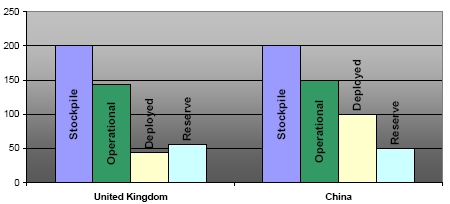 |
|
Britain and China both claim to have the lowest number of nuclear weapons of the original five nuclear weapon states. Both refuse to say how many they have. In reality, the two countries are estimated to have about the same total number of nuclear warheads, but the numbers can very considerably depending on which part of the posture is presented. |
The two postures differ significantly. China does not have a permanent deployment of nuclear weapons at sea, and most (if not all) of China’s land-based missiles are thought to be deployed without the nuclear warheads installed. Unlike Britain, moreover, China has a no-first-use policy for its nuclear weapons.
In the future, however, China may have to revisit its statement about its nuclear weapons inventory. Whereas the British stockpile has declined an is unlikely to increase in the future, the Chinese stockpile may be increasing some in the next decade.
Confidence Reaffirmed (Silly Secrecy Too)
The statements made by the two countries have revealed a curious phenomenon: both apparently are confident that they know how many nuclear weapons the other has. Indeed, confidence appears to be so high that both are willing to say so in public.
This is curious because both countries insist that the size of their nuclear stockpiles must be kept a secret, or national security would be jeopardized. But if they both know the size of the other’s arsenal, who are they keeping it secret from?
Background: Britain’s Next Nuclear Era | Chinese Nuclear Forces and U.S. Nuclear War Planning | British Nuclear Forces, 2005
China Reorganizes Northern Nuclear Missile Launch Sites
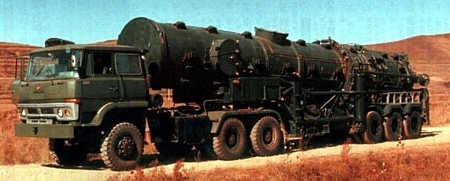 |
|
A dozen trucks identified at possible missile launch sites near Delingha in the northern parts of central China resemble the DF-21 medium-range ballistic missile launcher. If correct, about a third of China’s DF-21 inventory is deployed within striking distance of Russian ICBM fields. |
By Hans M. Kristensen
China has significantly reorganized facilities believed to be launch sites for nuclear ballistic missiles near Delingha in the northern parts of Central China, according to commercial satellite images analyzed by the Federation of American Scientists.
The images indicate that older liquid-fueled missiles previously thought to have been deployed in the area may have been replaced with newer solid-fueled missiles. From the sites, the missiles are within range of three Intercontinental Ballistic Missile (ICBM) fields and a bomber base in the southern parts of central Russia.
Analysis of Changes
The Chinese launch sites, which are located at an elevation of approximately 10,000 feet (3,000 meters), are in an area that for years has been rumored to be a deployment area for liquid-fueled DF-4 long-range nuclear ballistic missiles. In November 2006, FAS and NRDC published Chinese Nuclear Forces and U.S. Nuclear War Planning, which used satellite images to describe the two launch sites. Several other apparent sites nearby did not have any infrastructure and many appeared abandoned.
|
|
 |
|
The launch sites are located at approximately 10,000 feet (3,000 meters) on the slopes of this mountain range north of Delingha. This image (used with permission) was shot approximately six miles (10 kilometers) from Delingha. |
The southern launch site has changed most dramatically. In late-2005, the site had what appeared to be a large missile garage, approximately 40 small buildings (possibly crew quarters), and more than half a dozen service trucks. A gate was also visible. In the new image from late-2006, all of those features are gone with only a single service truck visible on the launch pad, and the access road appears to have been paved (see below).
|
|
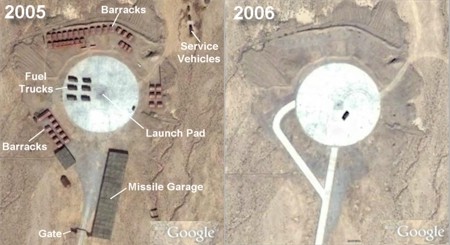 |
|
The southern launch site at Delingha (37°24’27.47″N, 97° 3’21.18″E) changed dramatically between late-2005 (left) and late-2006. All buildings were been removed and only a few small trucks remain. The 250-feet (80-meters) launch pad and the access roads have been paved. |
The second launch site some 2.5 miles (4.3 km) to the north has also changed significantly, but here operations appear to have increased. In late-2005, this site included what appeared to be a missile garage, an underground facility, approximately 15 buildings, and less than a dozen service trucks of various sizes. The new satellite image from late-2006, however, shows that the large garage has been removed, the number of buildings nearly doubled, the access roads paved, and work appears to be in progress next to the underground facility (see below).
|
|
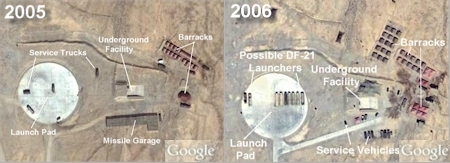 |
|
The northern primary launch site has been expanded significantly between late-2005 (left) and late-2006. Numerous new buildings have been erected, the access roads have been paved, work appears to be in progress next to the underground facility, and six 13-meter trucks that resemble launchers for the DF-21 MRBM are clearly visible on the launch pad. Check it out on Google Earth. |
Most interestingly, clearly visible are eight 13-meter trucks lined up on the launch pad. The satellite image is not of high enough resolution to identify the trucks and their features with certainty, but they strongly resemble the six-axle transport erector launchers (TELs) in use with the 10-meter DF-21 medium-range ballistic missile. A vague line across the trailer two-thirds toward the rear resembles the position of the hydraulic pumps used to erect the missile canister to a vertical position.
|
|
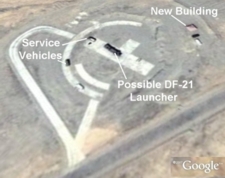 |
|
Possible DF-21 launchers are also visible at several of a dozen smaller possible launch sites. This one, north of the main site (Site 2), has also been upgraded with a new building. |
Changes to Other Delingha Sites
The two launch sites described above are the most actively visible in the satellite images. But there are more sites that appear to be involved in missile operations. North along the main road is what appears to be five smaller dispersed parking or launch platforms. None of these sites had any vehicles or infrastructure visible in 2005, but the new image shows one 13-meter truck present at four of the five sites. One of the sites appears to be upgrading with new access roads, a building, and half a dozen service vehicles (see right).
Further to the west, approximately 10 miles (17 km) from site 1 and 2, is another road leading north into the mountains. Along this road, another eight possible dispersal launch sites are visible. No 13-meter trucks, buildings, or other vehicles are visible at these sites.
The DF-21 Medium-Range Ballistic Missile
The DF-21 is a medium-range ballistic missile estimated by the U.S. Defense Intelligence Agency (DIA) to have a range of approximately 1,330 miles (2,150 kilometers). It is China’s first solid-fueled ballistic missile and believed to carry a single warhead with a yield of 200-300 kilotons. Full operational deployment began in 1991. The missile is approximately 33 feet (10 meters) long and launched from a six-axle transporter erect launcher (TEL). Two versions of the missile are deployed, according to the DOD. Some might have been converted to carry conventional warhead.
|
|
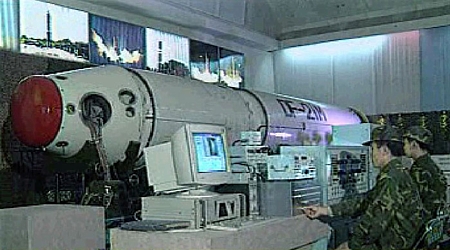 |
|
A DF-21 medium-range ballistic missile during calibration. |
The Defense Intelligence Agency estimated in 1996 that the DF-21 was expected to complement and possibly take over the strategic targeting role of the DF-3 by 2000. But introduction was slow. Whether this is now happening, and whether the DF-21 is also replacing DF-4s in some roles is unknown. The DOD’s annual report on China’s military power for years showed great uncertainty about the number of DF-21s, the 2006 report listing a range of 19-50 missiles on 34-38 launchers. The 2007 report, however, lists 40-50 missiles on 34-38 launchers, which suggests the DOD believes the number of missiles has increased while the number of launchers has stayed the same.
|
|
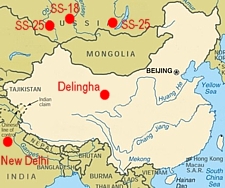 |
|
From Delingha the DF-21 is in range of northern India (including New Delhi) and three Russian ICBM fields and a bomber base. |
Uncertainties and Implications
It is important to caution that there is no information publicly available that confirms that the Delingha sites are launch sites for ballistic missiles, or that the 13-meter trucks indeed are DF-21 launchers. First, the changes at the sites may be routine because nearly all of China’s ballistic missile are mobile, and the support units are designed to follow the launchers wherever they go. Second, the rumored DF-4 deployment in the area may have been wrong, or the DF-21 may have moved in years ago but only been publicly visible now. U.S. and Russian spy satellites probably have monitored the changes at Delingha on a daily basis and provided a much more detailed understanding of what is happening at the sites.
Yet the indications that the DF-21 is deployed at Delingha appear to be strong. And if the dozen 13-meter trucks visible on the satellite images at Delingha indeed are DF-21 TELs, then 32-35 percent of China’s estimated inventory of DF-21 launchers are deployed in central China.
With a DIA-listed range of 1,330 miles (2,150 kilometers) the DF-21s would not be able to reach any U.S. bases from Delingha, but they would be able to hold at risk all of northern India including New Delhi. Moreover, and this is perhaps the most interesting implication of the discovery, DF-21s would be within range of three main Russian ICBM fields on the other side of Mongolia: the SS-25 fields near Novosibirsk and Irkutsk, the SS-18 field near Uzhur, and a Backfire bomber base at Belaya.
Whereas targeting New Delhi could be considered normal for a non-alert retaliatory posture like China’s, targeting Russian ICBM fields and air bases would be a step further in the direction of a counterforce posture. But again, it is unknown exactly what role the Delingha missiles have, and the DF-21 may not be accurate enough to pose a serious risk to hardened Russian ICBM silos. Regardless of targeting, Delingha appears to be very active.
|
|
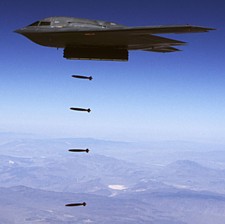 |
|
A single B-2 stealth bomber with conventional JDAM bombs would probably be sufficient to incapacitate the Delingha missile launch sites. |
One of the most striking features about the sites is their high vulnerability to attack. All appear to be almost entirely surface-based facilities (although Site 2 has an underground structure), and a mobile missile launcher is extremely vulnerable once it has been discovered. The sites were possible DF-21 launchers were detected are located within a distance of about six miles (10 kilometers). A single high-yield nuclear warhead would probably be sufficient to neutralize the entire force visible in the images.
But an adversary might not even have to cross the nuclear threshold. A single U.S. B-2 bomber loaded with non-nuclear JDAM bombs (see this video) would probably be sufficient to neutralize the dozen launch sites seen in the images. The United States has begun to incorporate such advanced conventional weapons into its strategic strike plans to give the president “more options.” Since China has repeatedly pledged that it “will not be the first to use such [nuclear] weapons at any time and in any circumstance,” some might conclude that a conventional strike on Chinese nuclear forces would not trigger Chinese use of nuclear weapons. But whether Beijing (or anyone else) would indeed stand idle by as its nuclear forces were taken out by conventional weapons is highly questionable.
Background: Chinese Nuclear Forces and U.S. Nuclear War Planning | Delingha on Google Earth
New Chinese Ballistic Missile Submarine Spotted
By Hans M. Kristensen
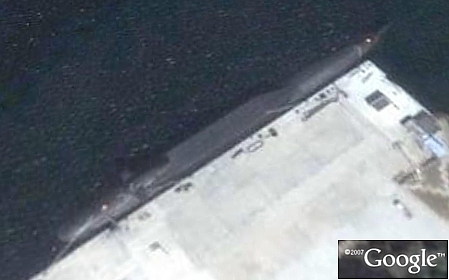 |
|
A new satellite image appears to have captured China’s new ballistic missile submarine. Coordinates: 38°49’4.40″N, 121°29’39.82″E. |
A commercial satellite image appears to have captured China’s new nuclear ballistic missile submarine. The new class, known as the Jin-class or Type 094, is expected to replace the unsuccessful Xia-class (Type 092) of a single boat built in the early 1980s.
The new submarine was photographed by the commercial Quickbird satellite in late 2006 and the image is freely available on the Google Earth web site.
A Comparison of SSBN Dimensions
Two satellite images are now available (see figure below) that clearly show two missile submarines with different dimensions. One image from 2005 shows what is believed to be the Xia-class (Type 092) SSBN in drydock at the Jianggezhuang Submarine Base approximately 14 miles east of Qingdao. The submarine is approximately 390 feet (120 meters) long of which the missile compartment makes up roughly 80 feet (25 meters). Twelve missile launch tubes are clearly visible.
The second image from late 2006 shows what appears to be the new Jin-class (Type 094) SSBN moored at the Xiaopingdao Submarine Base south of Dalian, approximately 193 miles north of Qingdao. The Jin-class appears to be approximately 35 feet (10 meters) longer than the Xia-class SSBN, primarily due to an extended mid-section of approximately 115 feet (35 meters) that houses the missile launch tubes and part of the reactor compartment.
|
Xia- and Jin-Class SSBN Comparison |
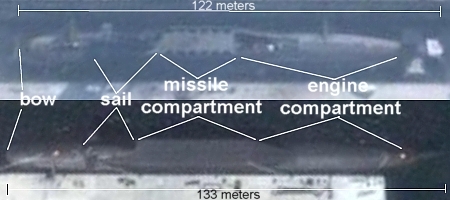 |
|
These two commercial satellite images of the old Xia-class SSBN (top) and the new Jin-class SSBN show the different major compartments. The Jin-class appears to be approximately 35 feet (10 meters) longer with an extended missile compartment. Both images view the submarines from a “eye-altitude” of approximately 500 feet (152 meters). |
The extended missile compartment of the Jin-class seems seems intended to accommodate the Julang-2 sea-launched ballistic missile, which is larger than the Julang-1 deployed on the Xia-class. Part of the extension may also be related to the size of the reactor compartment. The U.S. Office of Naval Intelligence estimated in 2004 that the Jin-class, like the Xia-class, will have 12 missiles launch tubes (see figure below). Other non-governmental sources frequently claim the submarine will have 16 tubes. The satellite image is not of high enough resolution to show the hatches to the missile launch tubes.
|
Estimated Jin-Class SSBN Layout |
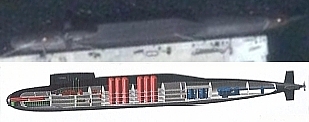 |
|
The U.S. Office of Naval Intelligence estimated in 2004 (bottom) that the Jin-class SSBN would have 12 missiles. |
The U.S. Office of Naval Intelligence estimated in December 2006 that China might build five Jin-class SSBNs. The estimate has been widely cited by non-governmental institutes and some news media as a fact, but the Pentagon’s annual report on China’s military forces from May 2007 did not repeat the estimate.
Background: Chinese Nuclear Forces and US Nuclear War Planning | Pentagon Report Ignores Five SSBN Projection
Pentagon China Report Ignores Five SSBNs Projection
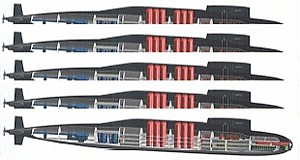 |
|
How many SSBNs are China building? |
The Pentagon’s new annual report on Chinese military power ignores a recent projection made by the Office of Naval Intelligence that China may be building five new ballistic missile submarines. The projection has since become a public “fact” after being spread around the world by news papers and private web sites.
Several news papers said earlier today – after the DOD report was leaked to them – that it identified the five Jin-class (Type 094) nuclear ballistic missile submarines. One senior defense official even was quoted saying that when the Chinese “develop five vessels like this, they are making a statement.”
Yet the DOD report does not say that China is building five SSBNs. In fact, it doesn’t give any number projection whatsoever. Instead, it repeats the projection from last year’s report that the first new SSBN may become operational sometime before the end of the decade.
So What Did Naval Intelligence Say?
When the news media first reported in March that the Office of Naval Intelligence (ONI) said China is building five Jin-class SSBNs, I requested the ONI report under the Freedom of Information Act. It is always good to check the primary source. The released report consists of answers to eight questions from Seapower Magazine about the Chinese submarine force.
Although some news media described the ONI report as saying China is building five SSBNs, ONI’s language was more vague, saying that “a fleet of probably five TYPE 094 SSBNs will be built in order to provide more redundancy and capacity for a near-continuous at-sea SSBN presence.” To me this language suggested that ONI was making a projection. So I asked ONI if it could clarify whether the number five was an assumption or a fact. In other words, does ONI know that five SSBNs are under construction (or ordered), or was the sentence a projection for what China would have to build if it wanted to have a near-continuous SSBN presence at sea?
The response was: “ONI can neither confirm or [sic] deny that ‘five’ is an actual number.”
Now that’s bureaucracy! If China is building five SSBNs, and ONI’s declassified letter to Seapower Magazine says that five are under construction, why can’t ONI confirm that five are under construction?
So I sent the declassified ONI letter to the Chinese Embassy and asked if they could confirm or deny. Here is what ONI and the media say. Are you building five SSBNs or not? Sorry, came the reply, even if we wanted to help you, no one here even knows the answer to your question.
I guess lack of transparency is a problem on both sides of the Pacific.
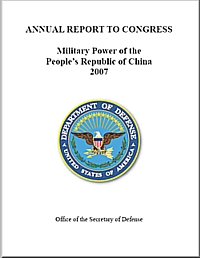
What the DOD Report Says
Perhaps there is disagreement within the intelligence community about the Chinese SSBN program. Perhaps DOD wanted to tone down the report and decided to remove ONI’s number from the final version. ONI said that
“a TYPE 094″ could reach Initial Operating [sic] Capability (IOC) as early as 2008,” but the submarine reaching IOC is not necessarily the same as the weapon system (including the JL-2) becoming operational. The DOD report limits itself to predicting that China’s strategic nuclear forces by 2010 likely include the JL-2.
In stark contrast with previous annual reports, the new report doesn’t highlight cases of dramatic Chinse submarine operations. Earlier this year I reported that Chinese submarines actually don’t sail on very many patrols; The single Xia SSBN not at all. The new DOD report does mention the Song-class submarine that “broached the surface in close proximity” to the U.S. aircraft carrier USS Kitty Hawk in October 2006 “in waters near Japan.” But rather than using the incident to warn about Chinese submarines pushing further and further into the Pacific, DOD uses it to talk about safety, saying it “demonstrated the importance of long-standing U.S. efforts to improve the safety of U.S. and Chinese military air and maritime assets operating near each other.”
DF-31 (Almost) Operational
Another “almost operational” new weapons system is the long-awaited DF-31, which finally has achieved what the DOD report calls “initial threat availability.” This allegedly occurred in 2006 after more than 20 years in development. DF-31 was first test flown in 1999 and most recently in September 2006. Actual operational capability will likely be achieved in the near future, if it has not already happened, the report states. The DF-31 will probably replace the DF-4 and likely be used for regional targeting against Guam, India and Russia.
DF-31A Operational in 2007?
A surprising prediction in the DOD report is that the longer-range version of the DF-31 – the DF-31A – may achieve IOC in 2007. This is surprising because there are no authoritative public reports, to my knowledge, that the DF-31A has yet been flight tested. The world has yet to see a picture – even a drawing – of the DF-31A. The missile is expected to supplement and eventually replace 20 old silo-based DF-5As that have been used to target the United States and Russia since the 1980s.
After the 2006 FAS/NRDC report (p. 58) described inconsistent DOD range maps for the DF-5A, the authors of the new DOD report (p. 19) have corrected the map which now shows the DF-5A as having a greater range than the DF-31A. The inaccurate range map became an issue in 2006 because it caused many news media to errouneously report that the new DF-31A will give China the ability to target all of the United States for the first time, although China has had the capability to do so with the DF-5/A since the early 1980s.
| DOD Corrects Missile Range Map | |
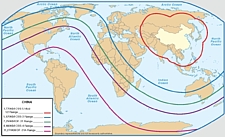 |
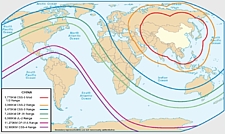 |
| The 2007 DOD report corrects the faulty missile range map from the 2006 report (left), which caused news media to write that the DF-31A would allow China to target all of the United States for the first time. The error was pointed out in the 2006 FAS/NRDC report. | |
Other Ballistic Missiles
The DOD report states that China maintains 40-50 DF-21s, an increase in the projection from the 19-23 missiles reported in 2005 and 19-50 in 2006. The reason for the changed estimate is unknown, but could be due to deployment of more conventional DF-21s. Another possibility is the DF-21’s long-awaited taking over the role of the DF-3A. It may also indicate that the “dip” in DF-21 reported by DOD in 2005 and 2006 in fact never happened.
The build-up of short-range conventional missiles continues off Taiwan, the DOD report says, with about 900 missiles had been deployed by October 2006. With a rate of about 100 missile per year, the number may have increased to approximately 950 by now. Even so, the report observes that things have been relatively quiet in the Taiwan Strait for the past two years.
The Nuclear Weapons Forecast
The DOD report does not give actual numbers for its projection of Chinese nuclear forces. It doesn’t repeat the 2001 CIA projection of 75-100 warheads primarily targeted against the United States by 2015, or mention the earlier DOD projection of 60 ICBMs primarily targeted against the United States by 2010. The new DOD report only lists the types of weapons it expect will make up the Chinese strategic nuclear arsenal by 2010: DF-4, DF-5A, DF-21, DF-31, DF-31A, JL-1, JL-2 and nuclear cruise missiles.
Depending on how many of each of the older weapon types that will remain, and how many of the new types China will actually produce and deploy in the next three years, I carefully estimate that the DOD list for 2010 translates into a Chinese arsenal of some 150-200 deployed nuclear warheads. The intelligence community does not appear to think that any of the new missiles will be equipped with multiple warheads.
Chinese Nuclear Policy
The DOD report continues previous years’ assessments of Chinese nuclear policy but now concludes that China’s no-first-use nuclear policy is “ambiguous.” The reason is that Chinese “doctrinal material” includes “additional missions for China’s nuclear forces,” DOD says, such as deterrence of conventional attacks against the Chinese mainland, reinforcing China’s great power status, and increasing its freedom of action by limiting the extent to which others can coerce China. A vigorous Chinese debate about the future role of nuclear weapons, combined with the “introduction of more capable and survivable nuclear systems in greater numbers suggest Beijing may be exploring the implications of China’s evolving force structure, and the new options that force structure may provide,” DOD states.
FAS and NRDC Almost Mentioned
The DOD report describes many more interesting statements than can be mentioned here, but one is a vague reference to the work FAS and NRDC did in 2006 where we analyzed commercial satellite photos of Chinese military facilities, including the nuclear submarine base at Jianggezhuang. In response to this (and several other cases), the DOD report describes, Chinese authorities warned that “foreigners who illegally survey, gather and publish geographical information on China will be severely punished.” DOD’s assessment of this series of events is that it “may indicate that China is attempting to lay the groundwork to extend the concept of the ‘information blockade’ into space.” Watch out DigitalGlobe; your QuickBird satellite may be next.
Background: Chinese Nuclear Forces and US Nuclear War Planning | Chinese Nuclear Forces Guide | Office of Naval Intelligence Letter
New US Navy Report on Chinese Navy
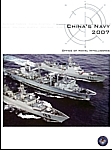
Despite frequent complains about lack of transparency in Chinese military planning, a new report from the Office of Naval Intelligence – recently described in the Washington Times and subsequently released to the Federation of American Scientists in response to a Freedom of Information Act request – boasts a high degree of knowledge about meticulous details of the Chinese navy’s operations, training, personnel and regulations.
The details in the report China’s Navy 2007 are many but unfortunately largely superfluous to the main answers many want to hear from the Office of Naval Intelligence (ONI) and other intelligence agencies: How are Chinese naval forces and operations evolving, and what do the changes mean?
Questionable Reporting
Unfortunately, some have already (mis)used the ONI report to hype fear that China is rising and out to get us. One example is the Washington Times, which last week described the report findings in a highly selective manner. Despite many unknowns about China’s military modernization and intentions, the paper’s description only included excerpts that indicate a threat or worrisome development. Moreover, the paper appears to have distorted the ONI report’s description of the Chinese submarine force’s importance: “China’s submarine forces are given ‘first priority’ of all branches of the navy, it states.”
But that’s not what the ONI report states. In fact, “first priority” as quoted by the Washington Times does not appear in the report at all. What the report says is very different: “The PLA Navy’s submarine forces…are generally listed as first in protocol order among the PLAN’s five branches.”
Being listed first in the protocol order is not the same as being the “first priority” of all the navy branches. According to the RAND Cooperation’s reference book The People’s Liberation Army as Organization:
| “PROTOCOL ORDER IN THE PLA: The PLA [People’s Liberation Army] is a very protocol oriented institution. When the PLA lists its military regions, services, service branches, administrative organizations, or its key personnel, the lists are almost always in protocol order, what the PLA calls organizational order (zuzhi xulie). The first criterion is generally the date a particular organization was established. For example, the order of the three services (junzhong) is always Army (August 1927), Navy (April 1949), and Air Force (November 1949). Since the Second Artillery Corps (July 1966) is technically a branch/service arm (bingzhong), and is usually not listed with the services….Therefore, the protocol order is more of an administrative tool today rather than a reflection of priority within the hierarchy.” (Emphasis added) |
What the ONI Report Does (and Doesn’t) Say
In contrast with the threat-focused style of the Washington Times reporting, the ONI report purports to have a much broader objective to “better understand the world’s fastest growing maritime power and its means of naval action and thereby foster a better understanding of China’s Navy.” The report observes up front that the enhanced naval power sought by China “is meant to answer global changes in the nature of warfare and domestic concerns about continued economic prosperity.” The drive to build a military component to protect the means of economic development, ONI states, “is one of the most prevalent historical reasons for building a blue water naval capability.”
Part of what has triggered the Chinese modernization is the extraordinary military capabilities that the United States have developed and deployed and demonstrated over the past two decades. The point is not that the United States is to blame and China just an innocent victim, but that all military modernization influences potential adversaries.
To that end the most interesting aspect about the ONI report may not be so much what it says but what it leaves out. Missing are many of the key developments that most concern US military planners and lawmakers, and many of the developments that are ignored by those who hype the Chinese “threat.”
For example, the ONI report does not include new information about the size of the Chinese navy. Instead it reprints a brief overview from the 2006 DOD report Military Power of the People’s Republic of China. Nor does the ONI report describe the construction of several new types of submarines, including the Type 093 nuclear-powered attack submarine and the Type 094 ballistic missile submarine.
Likewise, the ONI report begins with reprinting portions of two Chinese government documents, one of which states that the Chinese navy’s “capability of nuclear counter-attacks has also been enhanced.” This refers to China’s current possession of a single Xia-class ballistic missile submarine, but the ONI leaves out any information about what that enhancement actually is.
The other Chinese government statement used describes that the Chinese navy is “enhancing its capabilities in…nuclear counterattacks.” This is a hint that China is building a new class (Type 094 or Jin-class) of ballistic missile submarines that will be equipped with the long-range Julang-2 ballistic missile. Yet the ONI report does not give any details about the status of those programs much less what they mean for the Chinese navy or Chinese intentions.
In addition, the ONI report contains a very detailed description of the various categories of training used by the Chinese submarine force, yet it doesn’t mention submarine patrols with one word. The omission is curious because the report describes that Chinese submarines in the late 1970s began conducting independent sustained operations in the Pacific, and that “long-range navigation training is an important overall type of training for submarines.” So why leave out the important fact that the number of patrols have declined since 2000 rather than increased with the acquisition of more capable submarines?
To that end, the ONI report describes how the “basic hands-on and crisis-management training for strategic-missile submarines that cannot be conducted while the submarine is navigating underwater for long periods of time must be conducted on shore.” Yet it leaves out the important piece of information that China’s missile submarine Xia has never conducted a patrol.
Apparently, too little transparency is not only a problem in the Chinese military.
Balanced Reporting
One week before the Washington Times hyped the ONI report, the nominated commander of Pacific Command, Admiral Timothy J. Keating, testified before the Senate Armed Services Committee where he dismissed alarmist reports of recent gains in Chinese submarine development.
“If the reports are fairly accurate, they are well behind us technologically. We enjoy significant advantages across the spectrum of defensive and offensive systems, in particular undersea warfare,” he said according to Taipei Times. In an interview with the paper, Keating added: “Should it become necessary for us to put our forces [in harm’s way], the development of Chinese submarines are [sic] a concern to us, but it is hardly an insurmountable concern.”
Admiral Keating’s testimony was not covered by the Washington Times.
Breaking the cycle of military modernizations that trigger military modernizations is perhaps the biggest challenge in US-Chinese relations. Balanced reporting is another.
Background: China’s Navy 2007 | China Naval Modernization | FAS/NRDC Report
China’s Submarine Fleet Continues Low Patrol Rate

China’s entire submarine fleet conducted only two patrols in 2006, according to information declassified by the U.S. Navy and obtained by the Federation of American Scientists under the Freedom of Information Act. The low patrol rate follows a drop from an all-time high of only six patrols in 2000 to none in 2005. China’s single sea-launched ballistic missile submarine Xia, the data shows, has never conducted a deterrent patrol.
The low level of Chinese submarine patrols is a curious contrast to warnings by the Pentagon, some private institutes and news media that China is expanding its submarine operations deeper into the Pacific. Although Chinese submarines occasionally venture into the waters around Japan and Taiwan, the fleet is surprisingly inactive.
Since 1981, the first year for which patrol data is available, the Chinese submarine force has conducted an average of less than two patrols per year. The highest number of annual patrols conducted since 1981 was six patrols in 2000. In four years (1982, 1990, 1993 and 2005), no patrols were conducted at all. Over the 25-year period, the trend is that patrols have only increased from one per year to approximately 2.8 patrols per year.
|
Chinese Submarine Patrols |
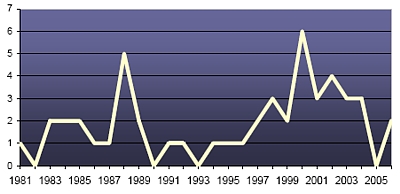 |
| The entire Chinese submarine fleet conducts less than three patrols per year on average. The ballistic missile submarine Xia has never conducted a deterrent patrol. |
So What is a Patrol?
The Navy has refused to tell FAS what a “patrol” is, saying doing so “would divulge methods and sources.” So interpretation of the data comes with a great deal of uncertainty. But the Defense Department’s unclassified Dictionary of Military Terms (JP 1-02) and earlier versions provide some hints by listing the following five definitions:
* Antisubmarine patrol: The systematic and continuing investigation of an
area or along a line to detect or hamper submarines, used when the direction
of submarine movement can be established.
* Inshore patrol: A naval defense patrol operating generally within a naval
defense coastal area and comprising all elements of harbor defenses, the
coastal lookout system, patrol craft supporting bases, aircraft, and Coast
Guard stations.
* Offshore patrol: A naval defense patrol operating in the outer areas of
navigable coastal waters. It is a part of the naval local defense forces
consisting of naval ships and aircraft and operates outside those areas
assigned to the inshore patrol.
* Patrol: A detachment of ground, sea, or air forces sent out for the purpose
of gathering information or carrying out a destructive, harassing, mopping up,
or security mission.
* Submarine patrol area: A restricted area established to allow submarine
operations: a. unimpeded by the operation of, or possible attack from, friendly
forces in wartime; b. without submerged mutual interference in peacetime.
If one assumes that U.S. Naval Intelligence’s use of the term “patrol” follows the DOD’s definitions, then the declassified patrol data suggests that Chinese general purpose submarines in 2006 twice conducted investigations to detect other submarines, participated in naval defense operations in coastal or outside coastal areas, or deployed for the purpose of gathering information or harassing. That implies an almost dormant submarine fleet.
The Song Incident
One of the two patrols conducted in 2006 appears to have been the widely reported surfacing of a Song-class diesel-electric submarine near the U.S. aircraft carrier USS Kitty Hawk in the South China Sea. The news media and pundits dramatized the incident as an example of China expanding its submarine operations, the Chinese government downplayed the reports as inaccurate, and the Pentagon said the media made too much of the incident.
“The bottom line is that […] they’re deploying them further and more frequently,” Defense News quoted an expert on the Chinese Navy at the National Defense University saying. China might even have a decisive submarine surge capability in 20 years, another pundit argued. “They are building a blue-water navy,” yet another expert warned. A politician in Taiwan thought it raises questions about “whether the U.S. in losing its military edge in the Western Pacific,” and commentators in both Taipei and Washington concluded that the incident showed that Taiwan needs to buy more submarines.
The Pentagon’s 2006 report Military Power of the People’s Republic of China stated that China was working on establishing a “first” or “second island chain” strategy for its naval forces, and that “Chinese forces have increased operations beyond China’s borders and coastal waters.” This may be the case for surface ships, but to illustrate the development the Pentagon highlighted “the highly publicized 2004 intrusion of a HAN-class nuclear submarine in Japanese territorial waters during operations far into the western Pacific Ocean.” DOD did not mention that the intrusion was one of only three patrols conducted by the entire Chinese submarine force in 2004, and that no patrols at all were conducted in 2005.
The U.S.-China Commission established by Congress after reports about Chinese spying, stated in 2006 that China is pursuing measures to try to “control” the seas in the Western Pacific, although “controlling” the seas is a daunting technological and operational task, and that China continues to “expand” its submarine force.
The Shrinking Chinese Submarine Fleet
Although China is modernizing its submarine force, it is not “expanding” it. Since the mid-1980s, the force has been in steady decline from nearly 120 boats to roughly 55 operational submarines today. The U.S. Navy expects the force will level out around 40 boats in the next decade.
|
The Shrinking Chinese Submarine Fleet |
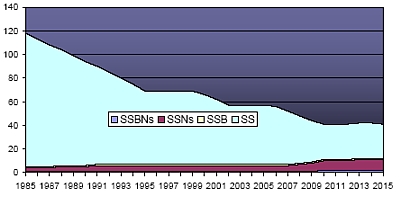 |
| The Chinese submarine fleet has declined by approximately 50 percent since the mid-1980s, mainly due to retirement of old and obsolete classes. Construction of new classes is underway but is not anticipated to lead to an increase, as the U.S. Navy expects the fleet will level out at around 40 submarines in the next decade. |
The decline of the submarine fleet is part of a transition where large older classes are being phased out and replaced with newer but less numerous submarine classes. The new submarines are more capable than the ones they replace, but the modernization has not resulted in an increase in the number of submarine patrols. On the contrary, during the period between 2000 and 2006, when China acquired a dozen new Kilo and Song class submarines, the number of patrols declined from six to two (with no patrols at all in 2005).
Implications
The implications of the low patrol rate are significant. The total operational experience for the entire Chinese submarine force is only 49 patrols in 25 years, corresponding to each submarine conducting an average of one patrol every third year.
As a result, Chinese submarine crews appear to have relatively little operational experience and consequently limited skills in operating their boats safely and competently. It suggests that the tactical skills that would be needed for the Chinese submarine force to operate effectively in a war may be limited.
China continues – at least for now – to use its submarine force as a coastal defense force.
Background: Chinese Nuclear Forces and U.S. Nuclear War Planning
Chinese Anti-Satellite Weapon Experiment; What Now?

In a major foreign policy blunder, China reportedly has conducted an anti-satellite (ASAT) test. First reported in Aviation Week and Space Technology, China allegedly used a medium-range ballistic missile to launch an unknown payload that slammed into the Feng Yun (FY-1C) polar-orbit weather satellite approximately 865 km (537 miles) above the earth on January 11.
China has long called for international talks to set limits on military space activities, but this has been rejected by the Bush administration, which also wants to develop and deploy ASAT weapons. On January 11, the same day China conducted the test, a senior State Department official told an Air Force military space conference that “there is no arms race in space that needs to be addressed” by arms control treaties.
The Chinese test is a surprise but not unexpected. Both the United States and Russia have worked on ASAT weapons for decades, and it was almost inevitable that China would follow in their footsteps. The Department of Defense stated in 2006 report on Chinese military forces:
“Beijing continues to pursue an offensive anti-satellite system. China can currently destroy or disable satellites only by launching a ballistic missile or space-launch vehicle armed with a nuclear weapon. However, there are many risks associated with this method, and potentially adverse consequences from the use of nuclear weapons. Evidence exists that China is improving its situational awareness in space, which will give it the ability to track and identify most satellites. Such capability will allow for the deconfliction of Chinese satellites, and would also be required for offensive actions. At least one of the satellite attack systems appears to be a groundbased laser designed to damage or blind imaging satellites.”
Others have suggested that Chinese ASAT capabilities were still far from deployment, but last week’s test suggests that China has made more progress than previously thought.
So What Now?
There will certainly be people who see the Chinese test as confirmation that the United States should rush to develop and potentially deploy ASAT weapons. And it is also likely to further deepen the military distrust between China and the United States. But it is important for national and international security that we think more sophisticated about this challenge and develop policies and options that increase security for all.
The first thing the Chinese test should teach us is that there now is an incipient arms race in space that urgently needs to be intercepted. With last week’s test, China has severely weakened its own status in the push for international limitations on military space activities. Yet the test may also serve to galvanize international efforts to prevent an arms race in space.
The second lesson is that the Bush administration’s rejection of limitations on military space activities has been a national security failure because it has granted China the legal freedom to test an ASAT weapon. ASAT weapons are a threat not only in war but also in peace because debris from ASAT tests endangers other military satellites as well as civilian satellites that are vital for monitoring atmospheric and environmental developments on Earth.
The third lesson the Chinese ASAT test should teach us is that the claim made by the 2001 Nuclear Posture Review and the 2006 Quadrennial Defense Review that U.S. pursuit of overwhelming capabilities (including in space) will somehow “dissuade” other countries from developing similar capabilities is a counterproductive and dangerous fallacy.
What is needed now is a combination of military constraint and reenergized political efforts:
First, China must refrain from further ASAT weapon testing and instead reaffirm its support for peaceful use of space.
Second, the United States and Russia must resist the temptation to resume their own ASAT testing programs.
Third, the Congress must review U.S. space policy in light of the new development.
Fourth, the Bush administration must abandon its opposition to limitations on the use of space and begin bilateral and international discussions on rules for military and civilian activities in space.
Background: Chinese Space | UCS Space Weapons Overview
Nuclear Missile Testing Galore
 (Updated January 3, 2007)
(Updated January 3, 2007)
North Korea may have gotten all the attention, but all the nuclear weapon states were busy flight-testing ballistic missiles for their nuclear weapons during 2006. According to a preliminary count, eight countries launched more than 28 ballistic missiles of 23 types in 26 different events.
Unlike the failed North Korean Taepo Dong 2 launch, most other ballistic missile tests were successful. Russia and India also experienced missile failures, but the United States demonstrated a very reliable capability including the 117th consecutive successful launch of the Trident II D5 sea-launched ballistic missile.
The busy ballistic missile flight testing represents yet another double standard in international security, and suggests that initiatives are needed to limit not only proliferating countries from developing ballistic missiles but also find ways to curtail the programs of the existing nuclear powers.
The ballistic missile flight tests involved weapons ranging from 10-warhead intercontinental ballistic missiles down to single-warhead short-range ballistic missiles. Most of the flight tests, however, involved long-range ballistic missiles and the United States, Russia and France also launched sea-launched ballistic missiles (see table below).
|
Ballistic Missile Tests |
||
| Date | Missile | Remarks |
| China | ||
| 5 Sep | 1 DF-31 ICBM |
From Wuzhai, impact in Takla Makan Desert. |
| France | ||
| 9 Nov | 1 M51 SLBM | From Biscarosse (CELM facility), impact in South Atlantic. |
| India | ||
| 13 Jun | 1 Prithvi I SRBM |
From Chandipur, impact in Indian Ocean. |
| 9 Jul | 1 Agni III IRBM |
From Chandipur. Failed. |
| 20 Nov | 1 Prithvi I SRBM |
From Chandipur, impact in Indian Ocean. |
| Iran** | ||
| 23 May | 1 Shahab 3D MRBM |
From Emamshahr. |
| 3 Nov | 1 Shahab 3 MRBM, as well as “dozens” of Shahab 2, Scud B and other SRBMs |
Part of the Great Prophet 2 exercise. |
| North Korea*** | ||
| 4 Jul | 1 Taepo Dong 2 ICBM and 6 Scud C and Rodong SRBMs |
From Musudan-ri near Kalmo. ICBM failed. |
| Pakistan | ||
| 16 Nov | 1 Ghauri MRBM |
From Tilla? |
| 29 Nov | 1 Hatf-4 (Shaheen-I) SRBM |
Part of Strategic Missile Group exercise. |
| 9 Dec | 1 Haft-3 (Ghaznavi) SRBM |
Part of Strategic Missile Group exercise. |
| Russia | ||
| 28 Jul | 1 SS-18 ICBM | Attempt to launch satellite, but technically an SS-18 flight test (see comments below). |
| 3 Aug | 1 Topol (SS-25) ICBM |
From Plesetsk, impact on Kura range. |
| 7 Sep | 1 Bulava SLBM |
From Dmitry Donskoy (Typhoon) in White Sea. Failed. |
| 9 Sep | 1 SS-N-23 SLBM |
From K-84 (Delta IV) at North Pole, impact on Kizha range. |
| 10 Sep | 1 SS-N-18 SLBM |
From Delta III in Pacific, impact on Kizha range. |
| 25 Oct | 1 Bulava SLBM |
From Dmitry Donskoy (Typhoon) in White Sea. Failed. |
| 9 Nov | 1 SS-19 ICBM |
From Silo in Baykonur, impact on Kura range. |
| 21 Dec | 1 SS-18 ICBM |
From Orenburg, impact on Kura range. |
| 24 Dec | 1 Bulava SLBM |
From White Sea. Third stage failed. |
| United States | ||
| 16 Feb | 1 Minuteman III ICBM |
From Vandenberg AFB, impact Kwajalein. Final W87/Mk-21 SERV test flight. |
| Mar/Apr | 2 Trident II D5 SLBMs |
From SSBN. |
| 4 Apr | 1 Minuteman III ICBM |
From Vandenberg AFB, impact near Guam. Extended-range, single-warhead flight test. |
| 14 Jun | 1 Minuteman III ICBM |
From Vandenberg AFB, impact Kwajalein. Three-warhead payload. |
| 20 Jul | 1 Minuteman III ICBM |
From Vandenberg AFB, impact Kwajalein. Three-warhead flight test. Launched by E-6B TACAMO airborne command post. |
| 21 Nov | 2 Trident II D5 SLBMs |
From USS Maryland (SSBN-738) off Florida, impact in South Atlantic. |
| * Unreported events may add to the list. ** Iran does not have nuclear weapons but is suspected of pursuing nuclear weapons capability. *** It is unknown if North Korea has developed a nuclear reentry vehicle for its ballistic missiles. |
||
The Putin government’s reaffirmation of the importance of strategic nuclear forces to Russian national security was tainted by the failure of three consecutive launches of the new Bulava missile, but tests of five other missile types shows that Russia still has effective missile forces.
Along with China, Russia’s efforts continue to have an important influence on U.S. nuclear planning, and the eight Minuteman III and Trident II missiles launched in 2006 were intended to ensure a nuclear capability second to none. The first ICBM flight-test signaled the start of the deployment of the W87 warhead on the Minuteman III force.
China’s launch of the (very) long-awaited DF-31 ICBM and India’s attempts to test launch the Agni III raised new concerns because of the role the weapons likely will play in the two countries’ targeting of each other. But during a visit to India in June 2006, U.S. Chairman of the Joint Chiefs of Staff, General Peter Pace, downplayed at least the Indian issue saying other countries in the region also have tested missiles. In a statement that North Korea would probably find useful to use, Gen. Pace explained that “the fact that a country is testing something like a missile is not destabilizing” as long as it is “designed for defense, and then are intended for use for defense, and they have competence in their ability to use those weapons for defense, it is a stabilizing event.”
But since all “defensive” ballistic missiles have very offensive capabilities, and since no nation plans it defense based on intentions and statements anyway but on the offensive capabilities of potential adversaries, Gen. Pace’s explanation seemed disingenuous and out of sync with the warnings about North Korean, Iranian and Chinese ballistic missile developments.
The Missile Technology Control Regime (MTCR) seeks to limit the proliferation of ballistic missiles, but that vision seems undercut by the busy ballistic missile launch schedule demonstrated by the nuclear weapon states in 2006. Some MTCR member countries have launched the International Code of Conduct Against Ballistic Missile Proliferation initiative in an attempt to establish a norm against ballistic missiles, and have called on all countries to show greater restraint in their own development of ballistic missiles capable of delivering weapons of mass destruction and to reduce their existing missile arsenals if possible.
All the nuclear weapons states portray their own nuclear ballistic missile developments as stabalizing and fully in compliance with their pledge under the Non-Proliferation Treaty to pursue nuclear disarmament in good faith. But fast-flying ballistic missiles are inherently destablizing because of their vulnerability to attack may trigger use early on in a conflict. And the busy missile testing in 2006 suggests that the “good faith” is wearing a little thin.
